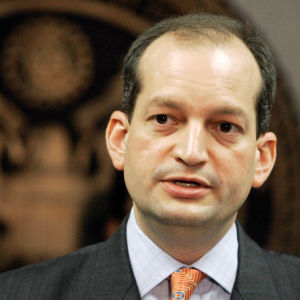Labor Secretary Alexander Acosta announced the release of a report Thursday aimed at fixing the skills gap through apprenticeship programs.
President Donald Trump has looked to address the skills gap problem by reforming training and apprenticeships. The Department of Labor (DOL) was instructed in an executive order last year to set up a task force to look into the issue. The task force submitted a report to the president with some recommendations on how to expand apprenticeships.
The DOL task force includes members from business, labor, trade groups, educational institutions, and public officials – who all approved of the report in their final meeting. The report specifically provides a strategy to create more apprenticeships across the country through an industry recognized apprenticeship model.
“President Trump’s Administration is committed to bridging the skills gap by creating apprenticeships that reflect the needs of jobs creators,” Acosta said in a statement. “The Task Force established through the President’s Executive Order brought together varied perspectives to create a strategy for expanding apprenticeships across all industries.”
President Trump has made workers a central focus of his administration since the beginning. The skills gap issue reflects a major problem with the workforce which has created both joblessness and job openings. The issue is many companies are having trouble finding workers with the skills they actually need. Technology is making the issue more prominent by changing the way industries operate, and the skills they need.
“The National Restaurant Association is honored to represent America’s restaurant and hospitality industry on the White House Task Force on Apprenticeship Expansion,” National Restaurant Association President Dawn Sweeney said in a statement provided to InsideSources. “We are thankful Secretary Alexander Acosta and the Trump Administration provided us a seat at the table to discuss the many ways our industry is creating advancement opportunities through apprenticeship for Americans from all backgrounds.”
The Bureau of Labor Statistics found in a 2015 report that the country is projected to produce one million fewer technical workers than are needed over the next decade. PNC Financial Services found in a report last year that the demand for STEM skills is going to explode over the next few years. The report also found that 38 percent of global manufacturers are having difficulty finding workers.
The DOL notes that when apprenticeship programs are implemented effectively, they can provide workers with a fulfilling career path by providing pay, skills development, and mentoring. The employer is benefited too as they can obtain the skills they need by training someone.
The task force divided itself into four subgroups which explored education and credentialing, attracting businesses, expanding access, and administrative strategies. The report recommends that access to training programs that are affordable be expanded and new standards be applied to programs to ensure they are educational. The report also outlines ways to work with businesses and other groups to improve or launch apprenticeship programs.
“Apprenticeships give students proven and meaningful ways to gain skills and kickstart fulfilling careers,” Education Secretary Betsy DeVos said in a statement. “I’m excited by the proposals the Task Force on Apprenticeships is putting forward to the President. We must continue our efforts to strengthen workforce readiness and increase the number of pathways available to students after high school.”
The Government Accountability Office (GAO) found in a 2011 report that the federal government spends about $18 billion annually on job training programs. Former President Barack Obama, for instance, invested $90 million into a federal program focused exclusively on apprenticeships.

